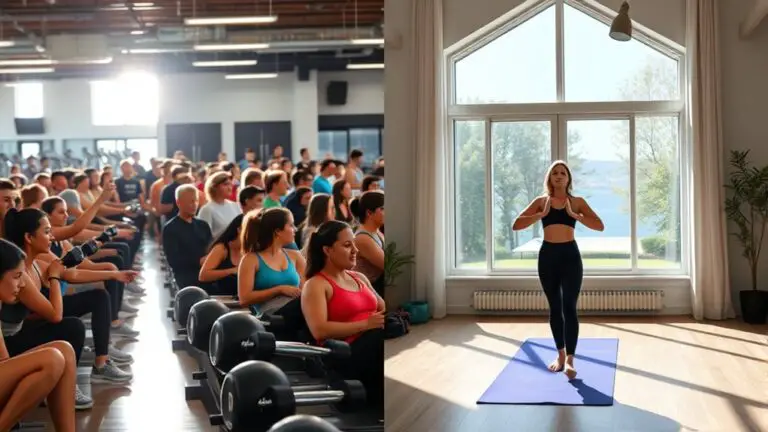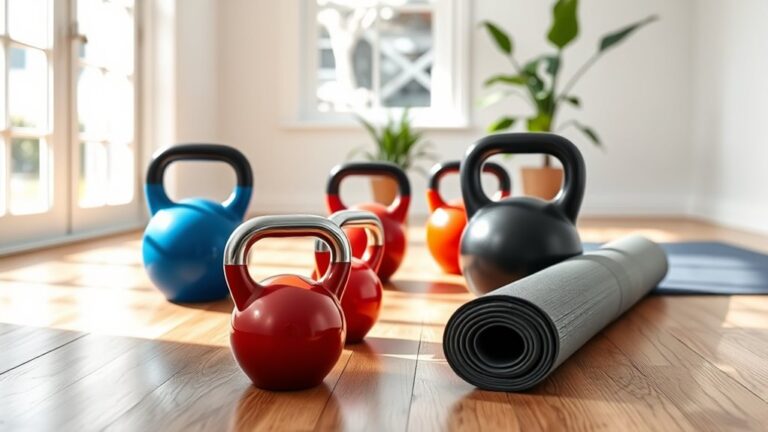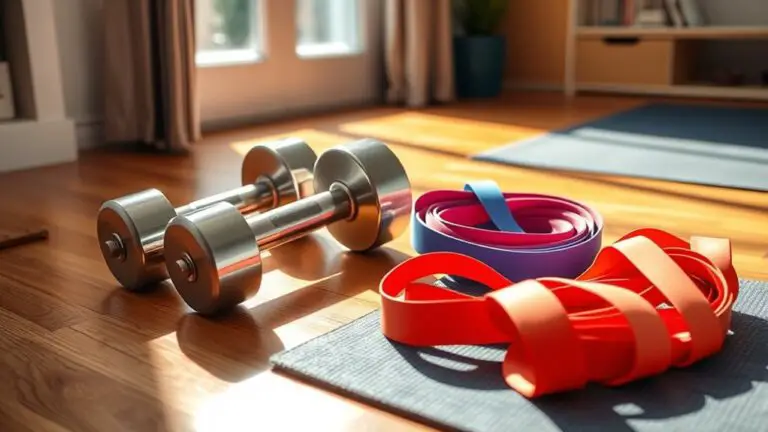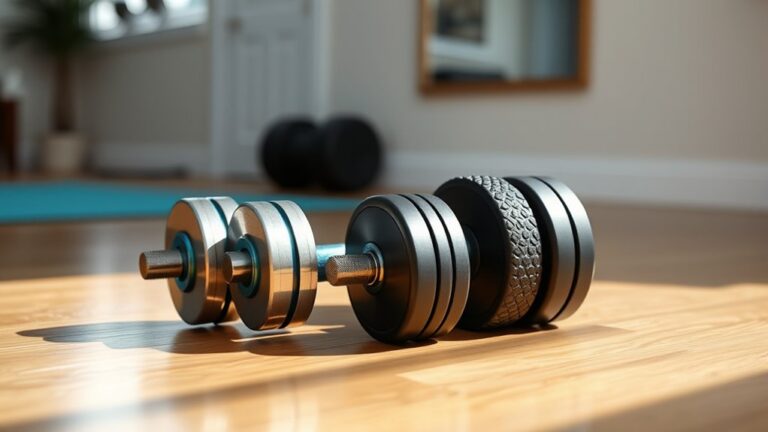How to Train Effectively With Limited Equipment

To train effectively with limited equipment, start by evaluating your space and inventory available gear like dumbbells or resistance bands. Focus on bodyweight exercises that engage multiple muscle groups. Use household items like water bottles as weights to add resistance. Create a balanced routine that mixes strength, cardio, and flexibility work. Leverage online resources for guided workouts and track your progress with apps. Keep your goals realistic and stay motivated—there’s more to discover about effective training strategies ahead.
Assessing Your Space and Equipment
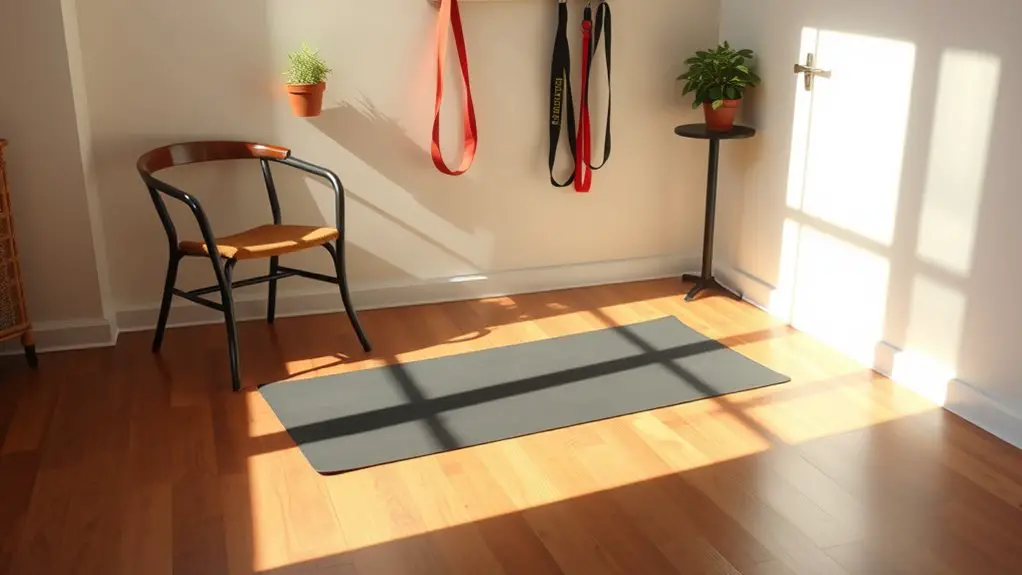
When you’re gearing up to train with limited equipment, the first step is to assess your space and what you have at your disposal. Conduct a thorough space evaluation to find a suitable area for your workouts. This could be a corner of your living room, a garage, or even a backyard. Confirm you have enough room to move freely without any hazards.
Next, perform an equipment inventory. Take stock of everything you own, from dumbbells and resistance bands to items like chairs or stairs that can be creatively utilized. Remember, even minimal equipment can be effective when leveraged correctly.
Consider how you can combine body movements and utilize your surroundings to maximize your training routine. With this clear understanding of your space and equipment, you’ll be well-prepared to create an efficient workout plan that keeps you motivated and engaged. Additionally, using our home gym calculator can help you optimize spending and space usage for your training setup.
Bodyweight Exercises for Full-Body Workouts
Now that you’ve assessed your space and inventory, it’s time to focus on bodyweight exercises that can deliver a full-body workout without the need for any additional equipment. You can achieve impressive results with effective bodyweight variations like push-ups, squats, lunges, and planks. These movements engage multiple muscle groups, promoting fitness adaptations that enhance strength, endurance, and stability.
To maximize your workout, try incorporating different variations to keep things interesting. For instance, elevate your feet during push-ups or switch to jumping squats for added intensity. Aim for a circuit format, repeating each exercise for 30 seconds with minimal rest in between. This approach not only keeps your heart rate up but also guarantees you’re working your entire body efficiently.
Additionally, incorporating jump rope into your routine can significantly improve cardiovascular health and engage your core muscles. With consistency and creativity, you’ll find that bodyweight exercises can be just as challenging and rewarding as traditional weight training. Get started today and feel the difference!
Incorporating Household Items as Weights

You don’t need fancy weights to get a great workout; your household items can be just as effective. Think creatively about how to use things like water bottles or bags of rice for resistance, but always keep safety in mind while lifting. With a little imagination, you can transform your home into a versatile gym.
Common Household Weights
Many people overlook the potential of everyday household items as effective workout weights. You can easily incorporate canned goods, like beans or soup, into your routine. They’re perfect for bicep curls or shoulder presses, providing a manageable weight for strength training. If you want to add more resistance, consider filling a backpack with books or other heavy items. This transforms it into a versatile weight that can be used for squats, lunges, or even as a makeshift kettlebell. Don’t underestimate the power of what’s around you! By creatively using common household items, you can enhance your workouts without needing fancy equipment, making your training both effective and accessible. Get started today; your home gym awaits!
Creative Resistance Techniques
While it might seem challenging to create a robust workout routine without traditional weights, incorporating household items can be a game changer. You can use makeshift weights like water bottles or bags of rice for resistance. Try band resistance techniques or towel resistance for added challenge. Incorporating isometric holds can enhance your core stabilization while performing gravity workouts. Don’t forget to mix in plyometric variations for a full-body burn! Dynamic stretching before and after your workouts helps improve flexibility. With creativity, you can effectively engage in functional training that keeps your body strong and adaptable. Remember, it’s not about the equipment you have, but how you use it to push your limits. Get started and make every session count!
Safety Considerations While Lifting
When lifting with household items as weights, prioritizing safety is essential to prevent injury and guarantee effective workouts. Start by confirming you maintain proper lifting posture; keep your back straight, engage your core, and bend at the knees. This helps distribute the weight evenly and reduces strain on your back. Choose items that are stable and easy to grip—like filled water bottles or bags of rice—to avoid unexpected slips. Always test the weight before lifting to confirm you can handle it comfortably. Listen to your body; if something feels off, stop and reassess. By focusing on injury prevention, you can enjoy the benefits of your workout while minimizing risks. Safety first will lead to long-term fitness success!
Creating a Balanced Routine

A well-rounded fitness routine is essential for maximizing your results, especially when working with limited equipment. To create a balanced routine, you need to incorporate a variety of exercises that target different muscle groups. This means mixing strength training with cardio, flexibility, and mobility work.
Start by selecting a few balanced exercises that you can perform with your available equipment—think push-ups, squats, and lunges. Then, add in some bodyweight movements and resistance bands for extra challenge. Aim for routine variety by changing the order of your exercises or adjusting the intensity weekly to keep your workouts fresh and engaging.
Don’t forget to include rest days and recovery techniques, as they’re just as important as your training days. By embracing this balanced and varied approach, you’ll not only enhance your performance but also prevent burnout and injuries, keeping you motivated on your fitness journey. Incorporating cardio exercises like skipping rope can effectively help in reducing thigh fat while enhancing your overall fitness.
Utilizing Online Resources and Apps
As you navigate your fitness journey with limited equipment, utilizing online resources and apps can greatly enhance your training experience. With countless online classes available, you can find workouts tailored to your equipment—whether it’s just a pair of dumbbells or resistance bands. These classes often offer variety, keeping your routine fresh and engaging.
Consider joining virtual fitness challenges. They not only provide motivation but also create a sense of community, connecting you with others who share similar goals. Engaging in these challenges can push you to reach new heights and maintain accountability.
Apps can also help streamline your workouts, offering guided sessions and tracking your progress. Many apps feature customizable routines, ensuring you maximize your limited equipment effectively. Embrace these tools; they’re designed to make your fitness journey easier and more enjoyable, regardless of your available gear. Remember, consistency in physical activity is key to sustaining motivation, so stay committed, and you’ll see results!
Setting Realistic Goals and Tracking Progress
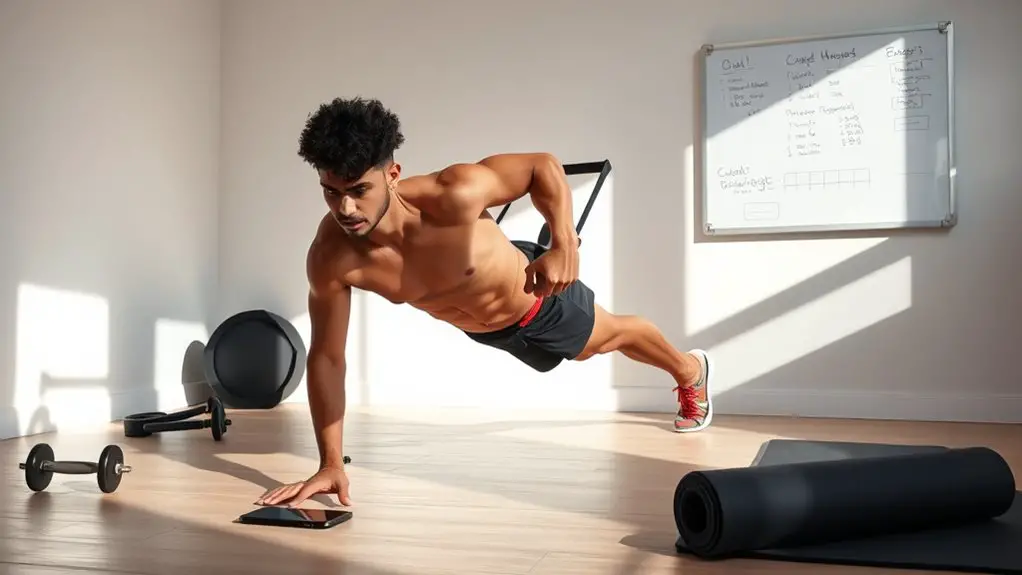
Next, incorporate progress tracking into your routine. Keep a journal or use an app to record your workouts and achievements. This not only helps you see how far you’ve come but also allows you to adjust your goals as needed. Celebrate small victories along the way; they’re essential for staying engaged. Remember, consistency is key, and tracking your progress will help you stay focused on your journey, no matter how limited your equipment may be. Additionally, consider incorporating an effective cardio workout like skipping rope to further enhance your fitness results.
Staying Motivated and Consistent
While it can be challenging to stay motivated when working with limited equipment, embracing a few practical strategies can make all the difference. First, set clear and achievable goals that keep you focused. Break larger objectives into smaller milestones to celebrate your progress along the way. This not only boosts your confidence but also reinforces your commitment.
Next, consider finding an accountability partner. Sharing your goals with someone who supports you can enhance your motivation and make workouts more enjoyable. Regular check-ins with your partner can help you stay on track and push through tough days.
Lastly, mix up your routine to keep things fresh and exciting. Explore different exercises that require minimal equipment, ensuring you remain engaged. Incorporating a jump rope into your routine can be a fun way to improve cardiovascular fitness while using limited resources. By implementing these strategies, you’ll cultivate a consistent training habit, making the most of your limited resources while achieving your fitness goals. Stay committed, and you’ll see progress!
Frequently Asked Questions
Can I Build Muscle Without Traditional Weights?
Absolutely, you can build muscle without traditional weights! Focus on bodyweight exercises like push-ups, squats, and lunges to engage multiple muscle groups effectively. Incorporating resistance bands can add extra challenge and variety, enhancing your workouts. These tools allow you to increase resistance as you progress, promoting muscle growth. Stay consistent, challenge yourself, and you’ll see results. Remember, it’s about finding what works for you and staying dedicated to your fitness journey!
How Often Should I Change My Workout Routine?
Ever feel like your workouts are on repeat? To keep your progress soaring, consider changing your routine every 4 to 6 weeks. This keeps your muscles guessing and promotes growth. By incorporating routine variety, you’ll not only avoid boredom but also enhance your workout frequency. Listen to your body; if you’re plateauing, it’s time for a shift. Embrace the change, and watch your strength and stamina flourish as you stay motivated!
What’S the Best Time of Day to Exercise?
When it comes to the best time of day to exercise, it really depends on your personal schedule and energy levels. Morning workouts can jumpstart your day and boost your mood, while evening routines might fit better if you’re not a morning person. Experiment with both to see which feels more natural. Ultimately, consistency is key, so choose a time that you can stick to regularly for the best results!
How Do I Prevent Injuries While Training at Home?
Training at home can feel like walking a tightrope; one misstep might lead to injury. To prevent this, always warm up and cool down—think of it as laying a solid foundation. Focus on proper form, listen to your body, and don’t rush. Incorporate strength and flexibility exercises into your home workouts, and allow rest days for recovery. With these injury prevention strategies, you’ll build a strong, resilient body that’s ready to tackle any challenge.
Is It Possible to Lose Weight With Limited Equipment?
Yes, you can definitely lose weight with limited equipment! Focus on effective weight loss strategies, like incorporating bodyweight exercises into your routine. Exercises such as push-ups, squats, and lunges can elevate your heart rate and build muscle, which helps burn more calories. Combine these workouts with a balanced diet, and you’ll see progress. Stay consistent, challenge yourself, and remember, every small step counts toward your weight loss goals!
